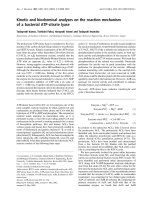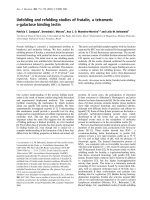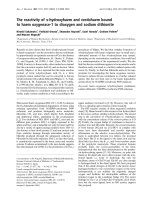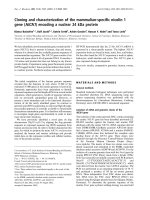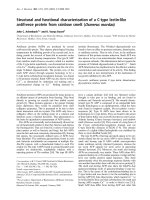Báo cáo y học: " Warfarin and fibrinolysis - a challenging combination: an observational cohort study" ppt
Bạn đang xem bản rút gọn của tài liệu. Xem và tải ngay bản đầy đủ của tài liệu tại đây (248.53 KB, 6 trang )
ORIGINAL RESEARCH Open Access
Warfarin and fibrinolysis - a challenging
combination: an observational cohort study
Sini Saarinen
1*†
, Jyrki Puolakka
1†
, James Boyd
1†
, Taneli Väyrynen
2†
, Harri Luurila
3†
and Markku Kuisma
1†
Abstract
Background: Patients presenting with ST-segment elevation myocardial infarction (STEMI) frequently use warfarin.
Fibrinolytic agents and warfarin both increase bleeding risk, but only a few studies have been published
concerning the bleeding risk of warfarin-prescribed patients receiving fibrinolysis. The objective of this study was to
define the prevalence for intracranial haemorrhage (ICH) or major bleeding in patients on warfarin treatment
receiving pre-hospital fibrinolysis.
Methods: This was an observational cohort study. Data for this retrospective case series were collected in Helsinki
Emergency Medical Service catchment area from 1.1.1997 to 30.6.2010. All warfarin patients with suspected ST-
segment elevation myocardial infarction (STEMI), who received pre-hospital fibrinolysis, were included. Bleeding
complications were detected from Medical Records and classified as ICH, major or minor bleeding.
Results: Thirty-six warfarin patients received fibrinolysis during the study period. Fourteen patients had bleeding
complications. One (3%, 95% CI 0-15%) patient had ICH, six (17%, 95% CI 7-32%) had major and seven (19%, 95%
CI 9-35%) had minor bleeding. The only fatal bleeding occurred in a patient with ICH. Patients’ age, fibrinolytic
agent used or aspirin use did not predispose to bleeding complications. High International Normalized Ratio (INR)
seemed to predispose to bleedings with values over 3, but no statistically significant differ ence was found.
Conclusions: Bleedings occur frequently in warfarin patients treated with fibrinolysis in the real world setting, but
they are rarely fatal.
Background
Pre-hospital fibrinolysis is an effective alternative in the
treatment of acute ST-segment elevation myocardial
infarction (STEMI). Reduced time delay from the onset
of symptoms to fibrinolysis is related to reduced mortal-
ity [1,2]. Many patients presenting with STEMI also have
other diseases, such as atrial fibrillation or severe heart
failure, requiring oral anticoagulants for the prevention
of thromboembolic complications. Guidelines of Eur-
opean Society of Cardiology, American College of Cardi-
ology (ACC) and American Heart Association (AHA)
consider the use of oral anticoagulants as a relative con-
traindication f or fibrinolysis [3-5]. The most t hreatening
complication associated with both warfarin and fibrinoly-
tic agents is an intracranial or a major bleeding, which
can be fatal. These patients are frequently transpo rted
directly to primary percutaneous coronary intervention
(PCI). According to the guidelines, fibrinolysis should,
however, be considered if PCI cannot be performed
within 90-120 minutes when emergency medical service
(EMS) meets the patient [3-5]. Additionally, the informa-
tion on prior warfarin usage is not always available,
especially in patients who are resuscitated from sudden
out-of-hospital cardiac arrest.
Even though bleeding associated with fibrinolysis has
been carefully investiga ted, only a few studies have be en
done concerning patients on oral anticoagulants receiv-
ing fibrinolysis. The aim of this study was to report the
prevalence of serious haemorrhages with patients on
oral anticoagulants receiving pre-hospital fibrinolysis for
suspected STEMI.
Methods
This was an observational cohort study approved by Insti-
tutional Review Board of Helsinki University Central
* Correspondence:
† Contributed equally
1
Helsinki Emergency Medical Service System, Helsinki University Central
Hospital, PL 112, 00099 Helsinki City, Helsinki, Finland
Full list of author information is available at the end of the article
Saarinen et al. Scandinavian Journal of Trauma, Resuscitation and Emergency Medicine 2011, 19:21
/>© 2011 Saarinen et al; licensee BioMed Central Ltd. This is an Open Access article distributed under the terms of the Creative
Commons Attribut ion License ( .0), which permits unr estricted use, distribution, and
reproduction in any medium, provided the original work is properly cited.
Hospital. The study plan was retrospective, but data was
collected prospectively for Fibrinolysis Registry in Helsinki
EMS area during 1.1.1997-30.6.2010. Helsinki is the capital
city of Finland with 584 000 inhabitants. The EMS consists
of seven to eight basic life support (BLS) -units, four
advanced life support (ALS) -units, a medical supervisor
unit and a physician staffed mobile intensive care unit
(MICU). The medical supervisor unit and the MICU are
provided with fibrinolytic agents.
All patients on warfarin were included, if they received
out-of-hospital fibrinolysis for suspected STEMI during
the study period. Unlike many other studies concerning
bleeding complications, this was a “real world s etting”
study including all patients despite their age, bleeding
risk or clinical condition. The decision to initiate fibri-
nolysis for suspected STEMI was made by an emergency
physician , either on scene or after consultat ion with 12-
lead electrocardiogram (ECG) transmission. Emergency
physicians in Helsinki EMS filled a detailed documenta-
tion form for Fibrinolysis Registry after each pre-hospi-
tal fibrinolysis. All patients receiving fibrinolysis for
suspected STEMI or pulmonary embolism are included
in the Fibrinolysis registry of Helsinki EMS, as well as
patients with suspected STEMI receiving other treat-
ment t han fibrinolysis (i.e. primary PCI). Only patients
receiving fibrinolysis for suspected STEMI were
included in the study. STEMI diagnose was not con-
firmed from Hospital Medical Records. Therefore it is
possible some patients received fibrinolysis inappropri-
ately not actually suffering from STEMI. However, a
physician responsible for maintaining t he registry
checked correctness of indications for fibrinolysis and
ECG diagnostics in all cases.
One of the authors (J.P) investigated the Medical
Records of receiving hospitals to detect possible compli-
cations after fibrinol ysis. Reported laboratory tests were
drawn on arrival to hospital. Bleeding complications
were classified as intracranial haemorrhage (ICH), major
and minor bleeding. ICH was diagnosed by computer
tomography (CT) scan or as an autopsy finding. Major
bleeding was defined a s a haemorrhage causing a need
for a blood-transfusion, all other bleedings reported in
Medical Records were defined as minor. Time from
fibrinolysis to bleeding, blood units transfused and treat-
ment of bleeding were also registered.
Statistical analysis was performed using SPSS for Win-
dows V18.0 Software (SPSS Inc, Chicago, IL, USA). Chi-
Square test (Fisher’s Exact Test) was used for categorical
variables and Mann-Whitney U test for continuous vari-
ables with non-normal distribution. Median values were
reported with 25th-75th percentiles and proportions
with 95% confidence intervals (95% CI) according to the
Agresti-Coull method. For statistical analysis ICH and
major bleeding groups were compared to minor and no-
bleeding groups. These two groups were chosen to be
compared on the basis of clinical relevance.
Results
Study population
Altogether 1322 pre-hospital fibrinolysis for suspected
STEMI were given during the study period. The study
population consisted of 36 warfarin treated patients,
whose baseline characteristics are shown in Table 1.
Eighty three percent (95% CI 68-93%) of study patients
were treated with fibrinolysis before year 2005. Chest
pain was the most common presenting symptom (n =
24; 67%, 95% CI 50 -80%). The main location of ST-
segment elevation was anterior wall in 18 (50%, 9 5%
CI 34-66%), inferior wall in 15 (42%, 95% CI 27-58%)
and lateral wall in 3 (8%, 95% CI 2-23%) patients.
Median time from the onset of the symptoms to fibri-
nolysis was 68 min (IQR 49-113 min), while median
time from emergency call to fibrinolysis was 51 min
(IQR 36-60 min). Other contraindications for fibrinoly-
sis than warfarin existed with four (11%, 95% CI 4-
26%) patients. Those were malignancy, hypertension
and previous ICH.
Table 1 Baseline characteristics of study patients (n = 36)
n (%, 95% CI)
Age (years)* 70 (62-78)
Sex; men 28 (78%, 62-89%)
Previous medical history
ischaemic heart disease 21 (58%, 42-73%)
hypertension 24 (67%, 50-80%)
diabetes 11 (31%, 18-47%)
myocardial infarction 17 (47%, 32-63%)
thrombolysis 9 (25%, 14-41%)
PCI or CABG 5 (14%, 6-29%)
use of aspirin 2 (6%, 1-19%)
Signs before fibrinolysis
cardiac arrest 10 (28%, 16-44%)
pulmonary oedema 1 (3%, 0-15%)
cardiogenic shock 5 (14%, 6-29%)
Warfarin
prior use known before fibrinolysis 34 (94%, 81-99%)
indication
atrial fibrillation 20 (55.5%, 40-70%)
cerebrovascular disease 6 (17%, 7-32%)
pulmonary embolism 1 (3%, 0-15%)
deep vein thrombosis 2 (5.5%, 1-19%)
heart valve disease 3 (8%, 2-23%)
cardiomyopathy 4 (11%, 4-26%)
* = median (IQR). PCI = Percutaneous Coronary Intervention, CABG = Coronary
Artery Bypass Graft Surgery.
Saarinen et al. Scandinavian Journal of Trauma, Resuscitation and Emergency Medicine 2011, 19:21
/>Page 2 of 6
Medication
Four fibrinolytic agents were used: streptokinase 1997-
2002, alteplase (tPA) 1997, reteplase 1998-200 7 and
tenecteplase 2008-2010 (Table 2). As adjuvant medica-
tion, aspirin 250 mg and/or unfractionated (UFH) or
low molecular weight heparin (LMWH) were used
(Table 2). UHF was given 5000 IU as a bolus and con-
tinued with infusion 1000 IU/h. LMWH was enoxapar-
ine, which was given 30 mg intravenously and 1 mg/kg
subcutaneously or only subcutaneously or intravenously.
UFH was replaced by LMWH after year 1999.
Laboratory test values
On arrival to hospita l, INR varied from 1.6 to 5.8. Med-
ian INR value was higher with ICH/major bleeding
group compared to minor an d no-bleeding group s
(Figure 1). Median ha emoglobin and thrombocyte count
values are shown in Table 2.
Bleeding complications
Bleeding complication occurred in 14 (39%, 95% CI
25-55%) patients, of whom only one had a bleeding
before hospital admission. Median time from fibrino-
lysis to bleeding was 22 h (IQR 6-47 h). Major bleed-
ing occurred in 6 (17%, 95% CI 7-32%) patie nts and
ICH in one patient (3%, 95% CI 0-15%). The site of
major bleeding was gastrointestinal in 3 (50% of
major bleedings) patients, unknown in 2 and pharynx
in one. In addition to gastrointestinal bleeding, hae-
mothorax was diagnosed in one patient. Major-bleed-
ing patients received on median 4 units of packed
red blood cells. The sites of minor bleeding were
puncture site, urinary or respiratory tract or ocular
angle.
Statistical findings
Statistically significant differences between ICH or major
bleeding - and minor or no-bleeding groups on age,
gender, blood pressure before fibrinolysis or heparin/
LMWH use were not foun d. Warfarin patients who
were medicated with aspirin prior to fibrinolysis, had
less bleedings than those who did not recei ve aspirin (p
= 0.037). Reteplase and tenecteplase use did not c ause
significantly less serious bleedings compared to other
Table 2 Comparison between patients with major bleeding or ICH, minor bleeding and no bleeding
ICH or major bleeding, n = 7 Minor bleeding, n = 7 No bleeding, n = 22
Age (years)* 69 (63-72) 67 (61-78) 70 (62-79)
Sex; men 7 (100%) 5 (70%) 16 (73%)
Earlier fibrinolysis 0 3 (43%) 6 (27%)
Contraindication for fibrinolysis (other than warfarin) 1 (14%) 0 3 (18%)
Systolic BP* 126 (105-141) 127 (90-140) 122 (111-140)
Diastolic BP* 64 (61-92) 69 (60-81) 76 (70-90)
Fibrinolytic agent
streptokinase 1 (14.3%) 0 5 (23%)
tPA (alteplase) 1 (14.3%) 1 (14.3%) 1 (4.5%)
reteplase 5 (71.4%) 5 (71.4%) 13 (59%)
tenecteplase 0 1 (14.3%) 3 (13.5%)
Adjuvant medication
aspirin 1 (14%) 3 (43%) 15 (68%)
heparin 5 (71%) 5 (71%) 14 (64%)
UFH 3 (43%) 1 (14%) 2 (9%)
LMWH 2 (29%) 4 (57%) 12 (55%)
LMWH (i.v.+s.c.) 1 (14%) 2 (29%) 3 (14%)
LMWH only i.v. 1 (14%) 2 (29%) 6 (27%)
LMWH reduced dose s.c 0 0 3 (14%)
Laboratory parameters at hospital arrival
thrombocytes (x10
9
/l)* 168 (144-191) 205 (165-227) 161 (134-188)
haemoglobin (g/l)* 153 (133-163) 145 (139-155) 136 (125-141)
Survival
hospital discharge 5 (71%) 5 (71%) 16 (73%)
30 days 5 (71%) 5 (71%) 14 (64%)
1 year 5 (71%) 4 (57%) 13 (59%)
* = median value (IQR), ICH = intracranial haemorrhage, BP = blood pressure, UFH = unfractionated heparin, LMWH = low molecular weight heparin, i.v. =
intravenously, s.c. = subcutaneously.
Saarinen et al. Scandinavian Journal of Trauma, Resuscitation and Emergency Medicine 2011, 19:21
/>Page 3 of 6
fibrinolytic agents (Table 2). A trend toward increasing
bleeding rates with high INR existed: median INR was
2.9 with ICH or major bleeding patient s, when no-
bleeding patients’ median INR was 2.3 (Figure 1). With
INR-value 2-3, 18% (95% CI 5-42%) had a severe bleed-
ing complication (ICH/major bleeding), whereas 38%
(95% CI 13-70%) had a severe bleeding with INR >3.
Statistical correlation between INR and bleedings was
not found.
Survival
Chest pain was relieved or ceased i n 26 (72%, 95% CI
56-84%) patients before hospital admission and ST-
segment elevation diminished over 50% 60-90 min after
fibrinolysis with 25 (69%, 95% CI 53-82%) patients. Two
(6%, 95% CI 1-19%) patients went into cardiac arrest on
scene after fibrinolysis. One of them died before hospital
admission. One bleeding complication, ICH, was fatal.
Thirty-day mortality was almost equal to 1-year mortal-
ity (Table 2).
Discussion
Bleedings occurred frequently after fibrinolysis with
patients on warfarin. Major bleeding or ICH occurred in
7 (19%, 95% CI 9-35%) patients in our study population.
Only one of the bleedings, i.e. ICH, was fatal.
Previously major bleeding - according to Thrombolysis
in Myocardial Infarction (TIMI) criteri a [6] or re quiri ng
blood transfusio n - has been reported to occur in 2.3%
to 8.3% of patients receiving fibrinolysis [7-9]. Gust o III
study consisting of over 15 000 patients showed the pre-
valence of major bleeding with reteplase and alteplase to
be 5.9% and 6.2%, respectively [10]. Compared to the
rates of ICH with non-warfarin patients receiving fibri-
nolysis in othe r studies (0.2-2.6%) [8-15], anticoagulated
patients had slightly higher probability for ICH (3%, 95%
CI 0-15%) in our study. According to Helsinki Fibrinoly-
sis Registry the prevalence of fatal ICH after pre-hospital
fibrinolysis in patients with suspected STEMI not receiv-
ing war farin was 1% (5/539, 95% CI 0- 2%) between
1997-2002 (unpublished registry data). Prevalence of
spontaneous ICH and major bleeding in warfarin
patients has been reported to be 0.25% and 1.1% yearly
in a previous study [16].
Only a few studies concerning the use of fibrinolytic
agents in anticoagulated patients are available. Stanley
et al did not find significant difference in serious com-
plications between warfarin and non-warfarin patients
bleedin g complications after fibrinolysis, but there was a
trend towards a greater prevalence of serious bleedings
with anticoagulated patients [17]. Their antic oagulated
fibrinolysis patients’ rate of any bleeding (4%) was note-
worthy lower than we found in our material, but their
amount of ICH (4%) was the same as in our st udy
population (3%) [17]. Stanley et al found that age,
aspirin use and repeated fibrinolysis increases bleeding
complications, but in our material no connection
between increasing bleeding rates and age or as pirin use
appeared. In our study patients receiving aspirin had sig-
nificantly lower rate of b leedings, but this might be
explained by a coincidence or some confoundi ng factors
since the size of population was relatively small. Brass
and co-workers investigated patients over 65 years old
and found that warfarin increased the risk of ICH only
if INR was over 4 [15], while in our population bleed-
ings seemed to increase already wit h INR-values over 3,
but no statistically significant difference existed. Jaegere
and co-workers (19 92) suggested 3.7-fold higher prob-
ability of ICH with patients on anticoagulants [18].
Patients on warfarin suffered from multiple diseases in
our unselected “ real world setting” study population;
ischaemic heart disease and previous myocardial infarc-
tions were common with them, as well as cardiogenic
shock or need for CPR. This may partially explain high
30-days and 1-year mortalities in warfarin patients.
Bleeding caused only one death in this group and it
does not therefore explain the high mortality.
Although fibrinolysis predisposes patients to bleeding
complications, the reported reduction in mortality with
pre-hospital fibri nolys is must be taken to consideration.
TerkelsenetalreportedSTEMI patients` mortalities
(15.4%; 23.3%; 28.1%; 3 0.8%) to increase as th e delay
from emergency dispatching center call to beginning
of reperfu sion therapy ( fibrinolysis or P CI) lengthens
BLEEDIN
G
INR
23451.5 2.5 3.5 4.5 5.5
Major/ICH Minor No bleeding
Figure 1 Individual and median INR values with ICH/major,
minor and no-bleeding groups. Median INR for ICH/major
bleeding group was 2,9 (IQR 2,5-3,7), for minor bleeding group 2,6
(IQR 1,9-3,5) and for no-bleeding group 2,3 (IQR 2,0-2,8).
Saarinen et al. Scandinavian Journal of Trauma, Resuscitation and Emergency Medicine 2011, 19:21
/>Page 4 of 6
(0-60 min, 61-120 min, 121-180 min, 181-360 min) [19].
This supports the acceptance of bleeding complication
risk with warfarin patients if PCI can not be performed
within the recommended time limit (120 min) [ 3-5]. In
identifying the high-risk patients for bleeding, knowing
the level of anticoagulation is valuable information.
Some of the rapid point-of-care laboratory analysators
used in ambulances have the capability to measure INR.
This study is limited by its retrospective nature, small
study population, and a lack of a control group. The num-
ber of warfarin patients’ fibrinolysis reduced notably after
year 2004, whe n Helsinki University Central Hospital of
Meilahti started organised PCI treatment for STEMI
patients 24 hours daily. Primary PCI is a common thera-
peutic practice with warfarin patients. Therefore it is diffi-
cult to collect a large enough population of warfarin
patients treated with fibrinolytic therapy to show signifi-
cant differences in variables predisposing to bleedings.
Also, several fibrinolytic agents and adjuvants were
used over time and therefore linking a certain medica-
tion regimen to increased bleeding risk is difficult con-
sidering the low number of patients. However, the use
of a various medication regimen reflects the changes in
clinical practise.
Conclusions
We conclude that with warfarin patients receiving fibri-
nolysis, bleedings are common, but only a few of them
are fatal. The level of anticoagulation is important
knowledge before giving fibrinolysis, because bleedings
seem to increase with high INR-values.
Acknowledgements and funding
None to declare.
Author details
1
Helsinki Emergency Medical Service System, Helsinki University Central
Hospital, PL 112, 00099 Helsinki City, Helsinki, Finland.
2
Helsinki EMS Research
Group, Helsinki University Central Hospital, PL 112, 00099 Helsinki City,
Helsinki, Finland.
3
Department of Cardiology, Helsinki University Central
Hospital of Meilahti, 00290 Helsinki, Finland.
Authors’ contributions
SS has analysed the data and drafted the manuscript. JP has collected the
data and has involved in revising the manuscript. JB and TV have given
assistance to analysing the data and have revised the manuscript. HL has
contributed in collecting the data and revising the manuscript. MK has been
a general supervisor and has involved in revising the manuscript and has
given the final approval of this article to be considered for publication. All
authors read and approved the final manuscript.
Competing interests
The authors declare that they have no competing interests.
Received: 17 December 2010 Accepted: 5 April 2011
Published: 5 April 2011
References
1. Björklund E, Stenestrand U, Lindbäck J, Svensson L, Wallentin L, Lindahl B:
Pre-hospital thrombolysis delivered by paramedics is associated with
reduced time delay and mortality in ambulance-transported real-life
patients with ST-elevation myocardial infarction. Eur Heart J 2006,
27:1146-1152.
2. Danchin N, Blanchard D, Steg P, Sauval P, Hanania G, Goldstein P,
Camou JP, Guéret P, Vaur L, Boutalbi Y, Genès N, Lablanche JM, USIC 2000
Investigators: Impact of Prehospital Thrombolysis for Acute Myocardial
Infarction on 1-Year Outcome. Circulation 2004, 110:1909-1915.
3. Van de Werf F, Bax J, Betriu A, Blomstrom-Lundqvist C, Crea F, Falk V,
Filippatos G, Fox K, Huber K, Kastrati A, Rosengren A, Steg PG, Tubaro M,
Verheugt F, Weidinger F, Weis M: Management of acute myocardial
infarction in patients presenting with persistent ST-segment elevation.
Eur Heart J 2008, 29:2909-2945.
4. Antman EM, Hand M, Armstrong PW, Bates ER, Green LA, Halasyamani LK,
Hochman JS, Krumholz HM, Lamas GA, Mullany CJ, Pearle DL, Sloan MA,
Smith SC Jr, Anbe DT, Kushner FG, Ornato JP, Pearle DL, Sloan MA,
Jacobs AK, Adams CD, Anderson JL, Buller CE, Creager MA, Ettinger SM,
Halperin JL, Hunt SA, Lytle BW, Nishimura R, Page RL, Riegel B,
Tarkington LG, Yancy CW: 2007 Focused Update of the ACC/AHA 2004
Guidelines for the Management of Patients With ST-Elevation
Myocardial Infarction. J Am Coll Cardiol 2008, 51:210-247.
5. Loomba R, Arora R: ST Elevation Myocardial Infarction Guidelines Today:
A Systematic Review Exploring Updated ACC/AHA STEMI Guidelines and
Their Applications. American Journal of Therapeutics 2009, 16 :e7-e13.
6. Bovill E, Terrin M, Stump D, Berke A, Frederick M, Collen D, Feit F, Gore J,
Hillis J, Lambrew C, Leiboff R, Mann K, Markis J, Fratt C, Sharkey S, Sopho G,
Tracy R, Chesebro J, the TIMI Investigators: Hemorrhagic events during
therapy with recombinant tissue-type plasminogen activator, heparin,
and aspirin for acute myocardial infarction:results of the Thrombolysis in
Myocardial Infarction (TIMI), phase II trial. Ann Intern Med 1991,
115:256-265.
7. López-Sendón J, Dabbous O, López de Sá E, Stiles M, Gore J, Brieger D, van
de Werf F, Budaj A, Gurfinkel EP, Fox KA, GRACE Investigators: In-Hospital
Outcomes Associated With Fibrinolytic and Thienopyridine Use in
Patients With ST-Segment Elevation Acute Myocardial Infarction. The
Global Registry of Acute Coronary Events. Rev Esp Cardiol 2009, 62:501-9.
8. Cannon CP, Bahit MC, Haugland JM, Henry TD, Schweiger MJ, McKendall GR,
Shah PK, Murphy S, Gibson CM, McCabe CH, Antman EM, Braunwald E:
Underutilization of Evidence-Based Medications in Acute ST Elevation
Myocardial Infarction Results of the Thrombolysis in Myocardial Infarction
(TIMI) 9 Registry. Critical Pathways in Cardiology 2002, 1:44-52.
9. Smalling R, Bode C, Kalbfleisch J, Sen S, Limbourg P, Forycki F, Habib G,
Feldman R, Hohnloser S, Seals A: More Rapid, Complete, and Stable
Coronary Thrombolysis With Bolus Administration of Reteplase
Compared With Alteplase Infusion in Acute Myocardial Infarction. RAPID
Investigators. Circulation 1995, 91:2725-32.
10. Topol E: Comparison of Reteplase with Alteplase for Acute Myocardial
Infarction. The Global Use of Strategies to Open Occluded Coronary
Arteries (GUSTO III) Investigators. N Engl J Med 1997, 337:1118-23.
11. Sabatine M, Morrow D, Montalescot G, Dellborg M, Leiva-Pons J, Keltai M,
Murphy S, McCabe C, Gibson M, Cannon C, Antman E, Braunwald E, the
Clopidogrel as Adjunctive Reperfusion Therapy (CLARITY)-Thrombolysis in
Myocardial Infarction (TIMI) 28 Investigators: Angiographic and Clinical
Outcomes in Patients Receiving Low-Molecular-Weight Heparin Versus
Unfractionated Heparin in ST-Elevation Myocardial Infarction Treated
With Fibrinolytics in the CLARITY-TIMI 28 Trial. Circulation 2005,
112:3846-3854.
12. ISIS-3 (Third International Study of Infarct Survival) Collaborative Group: A
randomised comparison of streptokinase vs tissue plasminogen
activator vs anistreplase and of aspirin plus heparin vs aspirin alone
among 41 299 cases of suspected acute myocardial infarction. Lancet
1992, 339:753-70.
13. Bode C, Smalling R, Berg G, Burnett C, Lorch G, Kalbfleisch J, Chernoff R,
Christie L, Feldman R, Seals A, Weaver W: Randomized
Comparison of
Coronary Thrombolysis Achieved With Double-Bolus Reteplase
(Recombinant Plasminogen Activator) and Front-Loaded, Accelerated
Alteplase (Recombinant Tissue Plasminogen Activator) in Patients With
Acute Myocardial Infarction. Circulation 1996, 94:891-8.
14. Gore J, Granger C, Simoons M, Sloan M, Weaver D, White H, Barbash G, Van
de Werf F, Aylward P, Topol E, Califf R, the GUSTO-I Investigators: Stroke
After Thrombolysis. Mortality and Functional Outcomes in the GUSTO-I
Trial. Circulation 1995, 92:2811-2818.
Saarinen et al. Scandinavian Journal of Trauma, Resuscitation and Emergency Medicine 2011, 19:21
/>Page 5 of 6
15. Brass L, Lichtman J, Wang Y, Gurwitz J, Radford M, Krumholz H: Intracranial
Hemorrhage Associated With Thrombolytic Therapy for Elderly Patients
With Acute Myocardial Infarction: Results From the Cooperative
Cardiovascular Project. Stroke 2000, 31:1802-1811.
16. Palareti G, Leali N, Coccheri S, Poggi M, Manotti C, D`Angelo A, Pengo V,
Erba N, Moia M, Ciavarella N, Devoto G, Berrettini M, Musolesi S: Bleeding
complications of oral anticoagulant treatment: an inception-cohort,
prospective collaborative study (ISCOAT). Lancet 1996, 348:423-428.
17. Stanley A, Fletcher S, Tan A, Barnett D: Is warfarin a contraindication to
thrombolysis in acute ST elevation myocardial infarction? Heart 2006,
92:1145-1146.
18. Jaegere P, Arnold A, Balk A, Simoons M: Intracranial Haemorrhage in
Association With Thrombolytic Therapy: Incidence and Clinical Predictive
Factors. J Am Coll Cardiol 1992, 19:289-294.
19. Terkelsen C, Sørensen J, Maeng M, Jensen L, Tilsted HH, Trautner S, Vach W,
Johnsen SP, Thuesen L, Lassen JF: System Delay and Mortality Among
Patients With STEMI Treated With Primary Percutaneous Coronary
Intervention. JAMA 2010, 304:763-771.
doi:10.1186/1757-7241-19-21
Cite this article as: Saarinen et al.: Warfarin and fibrinolysis - a
challenging combination: an observational cohort study. Scandinavian
Journal of Trauma, Resuscitation and Emergency Medicine 2011 19:21.
Submit your next manuscript to BioMed Central
and take full advantage of:
• Convenient online submission
• Thorough peer review
• No space constraints or color figure charges
• Immediate publication on acceptance
• Inclusion in PubMed, CAS, Scopus and Google Scholar
• Research which is freely available for redistribution
Submit your manuscript at
www.biomedcentral.com/submit
Saarinen et al. Scandinavian Journal of Trauma, Resuscitation and Emergency Medicine 2011, 19:21
/>Page 6 of 6



